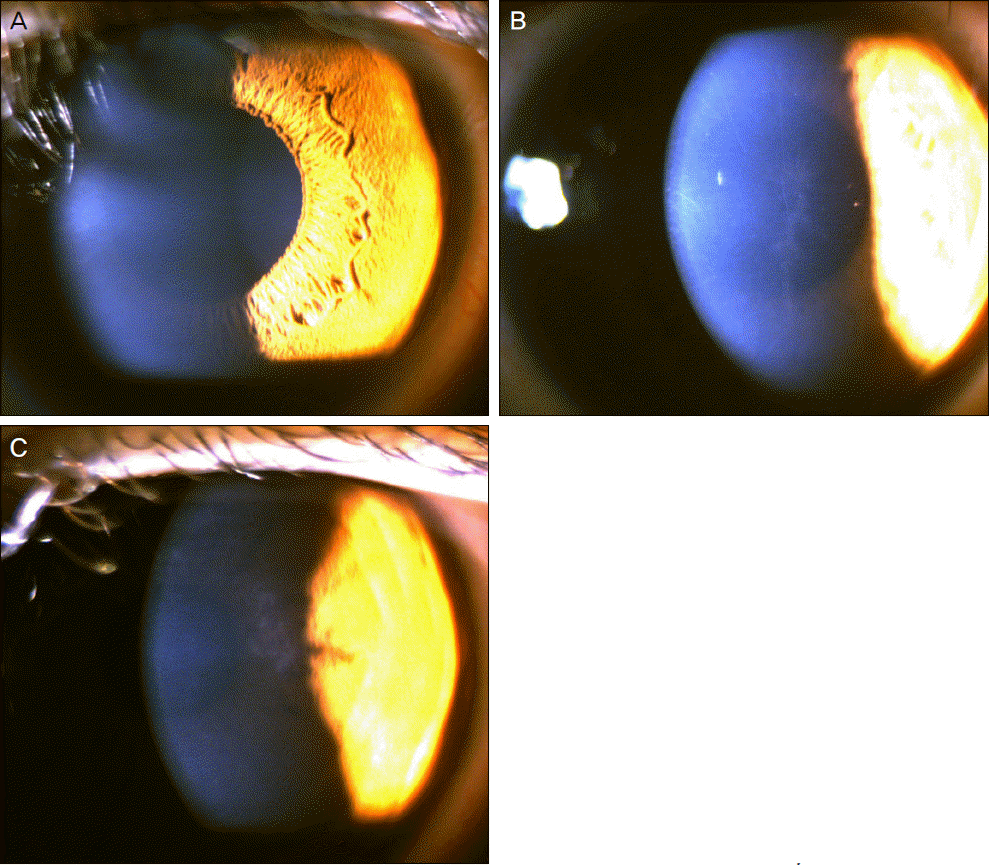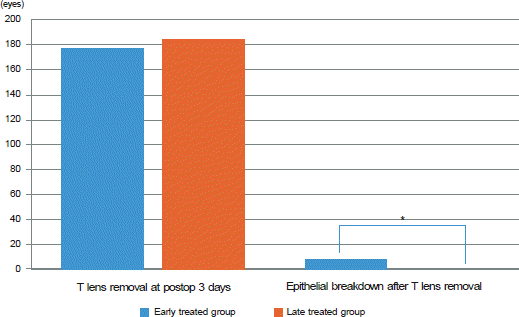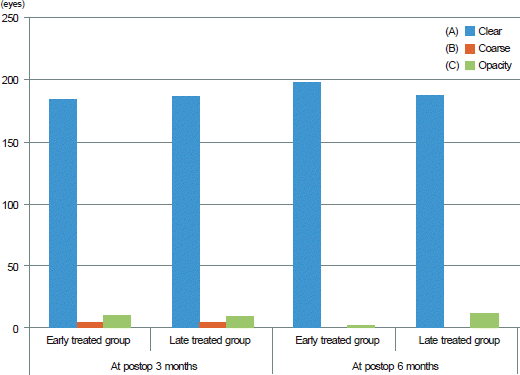Abstract
Purpose
To evaluate the clinical effects of early topical steroid treatment on corneal epithelium healing and postoperative corneal haziness after trans-epithelial photorefractive keratectomy (Trans PRK).
Methods
A total of 400 eyes from 200 patients who received Trans PRK with the Schwind Amaris laser platform (SCHWIND eye-tech solutions, Kleinostheim, Germany) were included in the present study. In 200 eyes (100 patients, early treated group) topical steroid was used from operation day but in the other 200 eyes (100 patients, late treated group) topical steroid was not used until therapeutic contact lenses were removed. The epithelial healing time, corneal haziness and visual acuity at postoperative 3, and 6 months were compared between the 2 groups.
Results
The therapeutic contact lenses could be removed at postoperative 3.50 ± 1.46 days and 3.14 ± 0.50 days in the early treated group and late treated group, respectively (p < 0.01). Breakdown of the epithelium after removal of therapeutic contact lenses occurred in 8 eyes, which were all in the early treated group. The difference of the visual acuity at postoperative 3 and 6 months between the 2 groups was not statistically significant. However, at postoperative 6 months, the corneal opacity developed in 12 eyes (6%) in the late treated group and 2 eyes (1%) in the early treated group (p = 0.01). Conclusions: Early treatment with topical steroid can delay corneal epithelial healing, especially the attachment of epithelium to stroma. However, the treatment can reduce the prevalence of corneal opacity after Trans PRK.
Go to : 
References
1. Lee SB, Chung MS. Advanced surface ablation-photorefractive keratectomy (ASA-PRK): safety and clinical outcome for the correction of mild to moderate myopia with a thin cornea. J Korean Ophthalmol Soc. 2006; 47:1274–86.
2. Jeong BJ, Kim HH, Park YJ, et al. Effect of mitomycin C to inhibit corneal haze formation after photorefractive keratectomy for high myopia. J Korean Ophthalmol Soc. 2006; 47:725–34.
3. Kim EC, Joo CK. Comparison of clinical result of epithelial removal during photorefractive keratectomy with blade to brush. J Korean Ophthalmol Soc. 2002; 43:1138–44.
4. Fadlallah A, Fahed D, Khalil K, et al. Transepithelial photo-refractive keratectomy: clinical results. J Cataract Refract Surg. 2011; 37:1852–7.

5. Arshinoff SA, Mills MD, Haber S. Pharmacotherapy of photo-refractive keratectomy. J Cataract Refract Surg. 1996; 22:1037–44.

6. Choi SY, Kim HY, Kim JY, et al. Two-year follow-up of eyes without topical corticosteroid treatment after photorefractive keratectomy (PRK). Korean J Ophthalmol. 1998; 12:25–9.

7. Chatterjee A, Shah S, Galway G. Effects of topical corticosteroids after photorefractive keratectomy. J Refract Surg. 1997; 13:S454–5.

8. Aras C, Ozdamar A, Aktunç R, Erçikan C. The effects of topical steroids on refractive outcome and corneal haze, thickness, and curvature after photorefractive keratectomy with a 6.0-mm ablation diameter. Ophthalmic Surg Lasers. 1998; 29:621–7.

9. Baek SH, Chang JH, Choi SY, et al. The effect of topical corticosteroids on refractive outcome and corneal haze after photo-refractive keratectomy. J Refract Surg. 1997; 13:644–52.

10. Bilgihan K, Ozdek S, Ozoul C, et al. Topical vitamin E and hydro-cortisone acetate treatment after photorefractive keratectomy. Eye (Lond). 2000; 14:231–7.

11. Vetrugno M, Maino A, Quaranta GM, Cardia L. A randomized, comparative open-label study on the efficacy of latanoprost and timolol in steroid induced ocular hypertension after photo-refractive keratectomy. Eur J Ophthalmol. 2000; 10:205–11.

12. Kuo IC, Lee SM, Hwang DG. Late-onset corneal haze and myopic regression after photorefractive keratectomy (PRK). Cornea. 2004; 23:350–5.

13. Vetrugno M, Maino A, Quaranta GM, Cardia L. The effect of early steroid treatment after PRK on clinical and refractive outcomes. Acta Ophthalmol Scand. 2001; 79:23–7.

14. Nien CJ, Flynn KJ, Chang M, et al. Reducing peak corneal haze after photorefractive keratectomy in rabbits: prednisolone acetate 1.00% versus cyclosporine A 0.05%. J Cataract Refract Surg. 2011; 37:937–44.

15. Weber BA, Gan L, Fagerholm PP. Short-term impact of corticosteroids on hyaluronan and epithelial hyperplasia in the rabbit cornea after photorefractive keratectomy. Cornea. 2001; 20:321–4.

Go to : 
 | Figure 1.Slit lamp photographs that show clear cornea (A), coarse cornea (B) and haze cornea (C) after trans epithelial photorefractive keratectomy. |
 | Figure 2.A graph that shows the differences of patients who can remove therapeutic contact lens at postoperative 3 days after trans-epithelial PRK and the incidence of epithelial breakdown after therapeutic contact lens removal in two groups. The groups are divided by the times when the topical steroid is used postoperatively. Epithelium breakdown after therapeutic contact lens removal happened in 8 eyes, which were all in topical steroid early treated group. *p = 0.001. |
 | Figure 3.Comparison graph of corneal clearance in Figure 1. Slit lamp photographs that show clear cornea (A), coarse cornea B) and haze cornea (C) after trans-epithelial photorefractive keratectomy. The two groups (200 eyes in topical steroid early treated group and 200 eyes in topical steroid late treated group) after trans-epithelial PRK with Schwind Amaris laser platform at postoperative 3 and 6 months, respectively. Clear = clear cornea; Coarse = coarse epithelium; Opacity = stromal opacity. |
Table 1.
Preoperative factors of patients who received trans-epithelial PRK operation with Schwind Amaris laser platform
Table 2.
Analysis of postoperative therapeutic lens removal in 400 eyes (200 patients) who received trans-epithelial PRK operation with Schwind Amaris laser platform
| T lens removal | Postoperative topical steroid | p-value* | |
|---|---|---|---|
| Early treated group (200 eyes) | Late treated group (200 eyes) | ||
| T lens off at postop 3 days (eyes) | 177 (89%) | 184 (92%) | 0.31 |
| T lens apply again after T lens off at postop 3 days (eyes) | 8 (4%) | 0 (0%) | 0.00 |
| No more T lens apply after T lens off at postop 3 days (eyes) | 0.169 (85%) | 0.184 (92%) | 0.0.01 |
| Postop period until final T lens off (days) | 0.3.50 ± 1.46 | 0.3.14 ± 0.50 | 0.<0.01 |
Table 3.
Analysis of postoperative factors in 400 eyes (200 patients) who received trans-epithelial PRK operation with Schwind Amaris laser platform




 PDF
PDF ePub
ePub Citation
Citation Print
Print


 XML Download
XML Download